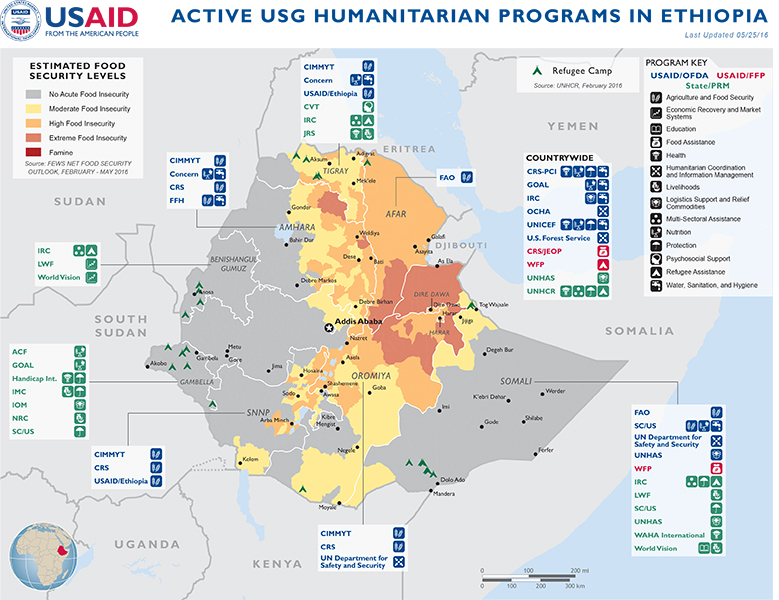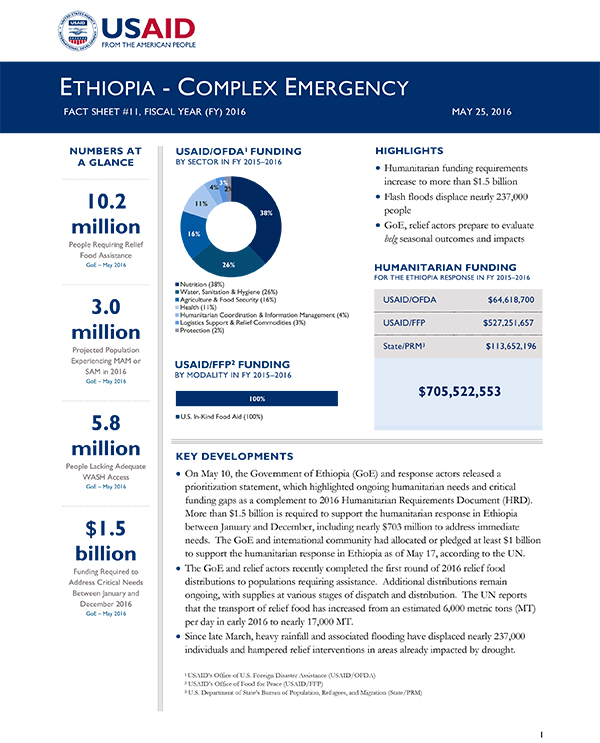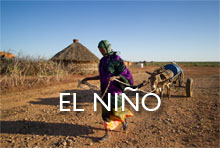- What We Do
- Agriculture and Food Security
- Democracy, Human Rights and Governance
- Economic Growth and Trade
- Education
- Ending Extreme Poverty
- Environment and Global Climate Change
- Gender Equality and Women's Empowerment
- Global Health
- Water and Sanitation
- Working in Crises and Conflict
- Disaster Assistance
- Political Transition Initiatives
- Conflict Mitigation and Prevention
- Countering Violent Extremism
- Disaster Risk Reduction
- Peacebuilding and Reconciliation
- Providing Safe & Secure Environments for Development
- Recovering From Crisis
- Resilience
- Tech Challenge for Atrocity Prevention
- World Humanitarian Day
- U.S. Global Development Lab
May 25, 2016
Highlights
Humanitarian funding requirements increase to more than $1.5 billion
Flash floods displace nearly 237,000 people
GoE, relief actors prepare to evaluate belg seasonal outcomes and impacts
Key Developments
Ethiopia Map - 05-25-2016 ![]() (pdf - 782k)
(pdf - 782k)
Numbers At A Glance
10.2 million
3.0 million
5.8 million
$1.5 billion
Humanitarian Funding
For the Ethiopia Response
FY 2015 - 2016
| USAID/OFDA | $64,618,700 |
| USAID/FFP | $527,251,657 |
| State/PRM | $113,652,196 |
| TOTAL | $705,522,553 |
On May 10, the Government of Ethiopia (GoE) and response actors released a prioritization statement, which highlighted ongoing humanitarian needs and critical funding gaps as a complement to 2016 Humanitarian Requirements Document (HRD). More than $1.5 billion is required to support the humanitarian response in Ethiopia between January and December, including nearly $703 million to address immediate needs. The GoE and international community had allocated or pledged at least $1 billion to support the humanitarian response in Ethiopia as of May 17, according to the UN.
The GoE and relief actors recently completed the first round of 2016 relief food distributions to populations requiring assistance. Additional distributions remain ongoing, with supplies at various stages of dispatch and distribution. The UN reports that the transport of relief food has increased from an estimated 6,000 metric tons (MT) per day in early 2016 to nearly 17,000 MT.
Since late March, heavy rainfall and associated flooding have displaced nearly 237,000 individuals and hampered relief interventions in areas already impacted by drought.
CURRENT EVENTS
On May 23, GoE Deputy Prime Minister Demeke Mekonnen chaired a side event focused on the Ethiopia drought response during the two-day World Humanitarian Summit (WHS) in Istanbul, Turkey. Event panelists included high-level representatives from USAID, the European Commission, the UN Office for the Coordination of Humanitarian Affairs (OCHA), the UN Children’s Fund (UNICEF), and the UN World Health Organization. Deputy Prime Minister Mekonnen and the participants discussed best practices and lessons learned from the current drought response, as well as the impact of GoE-led agriculture-, food-, and health-related disaster risk management and development efforts implemented over the last ten years.
Between late March and mid-May, intense rainfall across much of Ethiopia generated flash flooding that displaced nearly 237,000 people and damaged bridges, roads, and other key infrastructure, according to OCHA. Extended drought conditions in 2015 and 2016 have reduced soil absorption capacity across Ethiopia, increasing flood and landslide risks. Heavy rainfall and flash floods have also affected populations already vulnerable due to the drought emergency in much of central, eastern, and northeastern Ethiopia, hindering drought-related humanitarian interventions and delaying the dispatch and distribution of relief food assistance for food-insecure populations.
The GoE National Disaster Risk Management Commission (NDRMC) and relief actors—including USAID staff—are preparing for an assessment of the February-to-June belg season, which is expected to commence on June 5 and conclude by the end of the month. The assessment—led by the NDRMC with support from relief organizations—will evaluate the outcome of the belg season and resultant impacts on food security, livelihood, health, education, nutrition, and water, sanitation, and hygiene (WASH) conditions. Over a period of two–three weeks, assessment teams plan to travel to flood- and drought-affected woredas, or districts, especially in belg-producing areas. The seasonal assessment typically begins in late June; however, the GoE and response actors are initiating the assessment earlier due to floods in parts of Ethiopia.
Results from the belg assessment will inform planned revisions to the 2016 HRD, which the GoE released in December 2015. With input from relief actors, the GoE and OCHA released a prioritization statement on May 10, providing preliminary updates regarding critical interventions and sector funding gaps to inform donor funding and planning efforts. As a result, the original 2016 HRD appeal of $1.4 billion increased to more than $1.5 billion—of which nearly $703 million is required to address priority agriculture, food, nutrition, shelter, and other humanitarian needs through December. OCHA reports that the GoE and international donors had provided or pledged at least $1 billion towards the 2016 HRD as of May 17.
FOOD SECURITY
The GoE and relief actors recently completed the first round of 2016 relief food distributions, which began in late January. According to the UN World Food Program (WFP), approximately 69 percent of the second round of 2016 relief food assistance and 19 percent of the third round were distributed to beneficiaries as of May 11. The GoE and relief organizations had also dispatched approximately 11 percent of food supplies for the fourth round, which began on May 3; fourth round food distributions have not yet begun, WFP reports.
According to OCHA, the dispatch and distribution of food supplies have improved in recent weeks, with the transport of relief food increasing from an estimated 6,000 MT per day in early 2016 to nearly 17,000 MT per day—an increase of approximately 183 percent—as of mid-May. The Logistics Cluster—the coordinating body for humanitarian logistics activities, comprising UN agencies, non-governmental organizations (NGOs), and other stakeholders—is working to bolster logistics coordination capacities and mitigate challenges at local levels, including operational bottlenecks and limited staff and storage availability.
AGRICULTURE
The Disaster Risk Management–Agriculture Task Force (DRM–ATF) Strategic Advisory Group recently outlined operational plans for emergency seed interventions over the coming weeks. Relief actors are prioritizing emergency seed interventions in 17 drought-affected zones across four regions—Amhara, Oromiya, Tigray, and Southern Nations, Nationalities, and Peoples (SNNP). The emergency seed assistance is targeting populations in zones that experienced 50–90 percent harvest losses in 2015; zones with multiple priority one and priority two hotspot districts; zones where relief organizations have a proven capacity to respond; and zones where seed interventions are prioritized and response gaps are identified. According to the DRM–ATF Strategic Advisory Group, the operational plans also provide guidance regarding seed sources, procurement methods, and implementation and coordination mechanisms.
To date, USAID has provided nearly $10 million to address emergency seed needs in drought-affected areas of Ethiopia. USAID/OFDA, in partnership with USAID/Ethiopia, provided $3.9 million to the International Maize and Wheat Improvement Center (CIMMYT) for seed interventions to reach approximately 226,000 households across several regions. As of mid-May, CIMMYT had procured approximately 95 percent of planned emergency seed supplies and completed 80 percent of planned distributions to drought-affected farmers. USAID/OFDA has also provided approximately $4 million to USAID partner Catholic Relief Services (CRS) to deliver critical seed assistance for 77,000 households in affected areas.
USAID/FFP supports the GoE-led Productive Safety Net Program (PSNP) with an annual contribution of approximately $100 million to four NGO partners to implement development food assistance programs with chronically food-insecure communities; the PSNP traditionally includes a small seed component. To help fill the emergency seed response gap in nine districts in Amhara, USAID/FFP provided Food for the Hungry (FFH) nearly $1.9 million in new funding to deliver seeds to approximately 43,000 additional households
HEALTH, NUTRITION, AND WASH
Heavy April and May rains have also replenished water sources, supported pasture regeneration in drought-affected areas, and helped prepare land in some areas for June-to-August meher crop planting. In addition, relief actors have reduced water-trucking operations across much of Ethiopia in response to significant rainfall. The GoE and relief organizations have reduced active water-trucking vehicles from 400 to 145 due to improved access to safe drinking water, according to the WASH Cluster.
The GoE and relief actors anticipate that approximately 458,000 children will experience severe acute malnutrition (SAM) and 2.5 million children and pregnant and lactating women will experience moderate acute malnutrition (MAM) in Ethiopia during 2016.
According to UNICEF, the GoE and relief organizations admitted approximately 86,270 children experiencing SAM for treatment between January and March—an approximately 37 percent increase compared to the average January–March SAM caseload of approximately 63,000 children from 2011–2015. Oromiya was the most-affected region, with the GoE and relief actors admitting more than 36,900 children—approximately 41 percent of the national caseload—experiencing SAM for treatment. In Afar Region, the GoE and relief organizations admitted more than 9,100 children experiencing SAM between January and March, a nearly 100-percent increase compared to the same period in 2015.
Between February and April, the GoE and nutrition actors also provided targeted supplementary feeding support to more than 587,200 children and pregnant and lactating women experiencing MAM, according to WFP. In response to low nutrition commodity delivery levels, WFP is deploying targeted supplementary feeding coordinators across Ethiopia to augment the provision and scale-up of countrywide nutrition interventions.
In late April, the GoE and health actors supported a national vaccination campaign against measles and polio, targeting nearly 26 million children between six months and 14 years of age. The April vaccination campaign follows the integrated vaccination campaign against measles and meningitis in late 2015, which targeted approximately 5.3 million children younger than five years of age. USAID/OFDA has provided UNICEF with $1.8 million in FY 2016 funding to bolster logistics and supply-chain capacities related to the recent measles and polio vaccination campaign.
OTHER HUMANITARIAN ASSISTANCE
On May 23, the Government of Canada (GoC) pledged approximately $125 million to WFP and the World Bank to support the GoE-led PSNP. Through the new funding, which was announced at the outset of the WHS, the GoC will maintain the delivery of relief food assistance to communities in Ethiopia and bolster their longer-term resilience to food insecurity through livelihoods support, including water-resource management planning and small grants. The GoC has committed nearly $48 million for the Ethiopia response in 2015 and to date in 2016, according to OCHA.
CONTEXT
Multiple consecutive seasons of below-normal rainfall and the current effects of the El Niño climatic event have resulted in deteriorating agricultural, livestock, food security, and nutrition conditions in northeastern and central Ethiopia. By December 2015, the GoE estimated that 10.2 million people required relief food assistance and other humanitarian interventions during 2016.
USAID activated a Disaster Assistance Response Team (DART) on February 24, 2016, to lead the USG crisis response to the drought in Ethiopia. In support of the GoE, the DART is coordinating USG response activities in close partnership with the UN and other relief organizations. The DART—composed of humanitarian specialists based in Ethiopia—is addressing critical needs and examining ways to realign activities to respond to urgent assistance gaps. USAID also established an Ethiopia Drought Response Management Team (RMT) based in Washington, D.C., to support emergency response efforts in Ethiopia.
While drought remains a major contributor to vulnerability in Ethiopia, negatively affecting the lives and livelihoods of farmers and pastoralists, populations also continue to confront other challenges—including seasonal flooding, localized intercommunal conflict, above-average food prices, disease outbreaks, and limited access to health and WASH services—that contribute to sustained humanitarian needs and an ongoing complex emergency in Ethiopia.
On October 7, 2015, U.S. Chargé d’Affaires, a.i., Peter H. Vrooman re-declared a disaster for Ethiopia in response to the ongoing complex emergency.
PUBLIC DONATION INFORMATION
The most effective way people can assist relief efforts is by making cash contributions to humanitarian organizations that are conducting relief operations. A list of humanitarian organizations that are accepting cash donations for disaster responses around the world can be found at www.interaction.org.
USAID encourages cash donations because they allow aid professionals to procure the exact items needed (often in the affected region); reduce the burden on scarce resources (such as transportation routes, staff time, and warehouse space); can be transferred very quickly and without transportation costs; support the economy of the disaster-stricken region; and ensure culturally, dietary, and environmentally appropriate assistance.
More information can be found at:
- USAID Center for International Disaster Information: www.cidi.org or +1.202.821.1999.
- Information on relief activities of the humanitarian community can be found at www.reliefweb.int.










Comment
Make a general inquiry or suggest an improvement.